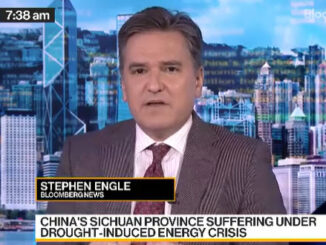
As the rest of the world grapples with rising living costs, China is facing the opposite problem: falling prices.
In July, the world’s second-largest economy officially slipped into deflation for the first time in two years as consumer prices fell 0.3 percent. Prices had already flatlined for much of 2023, bucking the global trend of spiking prices for everything from energy to food.
While lower prices might sound appealing to the average consumer, economists view deflation as a bad sign for the economy.
When prices fall over an extended period, consumers reduce spending and companies cut back on production – in turn resulting in layoffs and lower salaries.
The Chinese economy’s slide into deflation is the latest in a series of warning signs to raise doubts about the strength of its post-pandemic recovery.
Why are analysts concerned about falling prices in China?
China has slipped into deflation before, but economists are more concerned about the fall in prices this time round. The last time prices fell, in early 2021, millions of people were under lockdown and factories were shut due to COVID restrictions.
China is now supposed to be well on the road to recovery after lifting its harsh “zero COVID” restrictions late last year.
So far, China’s rebound has been lacklustre.
While economic growth has picked up from its low base during the pandemic, several investment banks have downgraded China’s outlook for 2023 amid expectations Beijing’s target of around 5 percent will not be met without major stimulus measures.
At home, Chinese consumers are still wary of spending after enduring gruelling lockdowns, depriving the economy of a crucial boost in consumption.
Overseas, countries are buying less from China’s factories amid the uncertain global economic outlook and geopolitical tensions.
The souring outlook comes as the Chinese economy could badly do with a jolt amid mounting challenges, including a record low birth rate, high levels of local government debt, a flagging real estate market, and high youth unemployment.
Why are analysts comparing China and Japan?
China’s economic travails have led some observers to recall the struggles faced by Japan in the early 1990s, when the collapse of a massive asset bubble resulted in a decades-long cycle of deflation and stagnant growth.
There are some noteworthy similarities between China’s current situation and where Japan was just before the bubble burst.
At the height of its economic boom in the late 1980s, Japan was the world’s second-largest economy and an export powerhouse known for its consumer electronics and cars – not unlike China today.
Japan suffered from decades of economic stagnation after the collapse of a massive asset bubble in the early 1990s [Kirby Lee/USA Today via Reuters]
Growing alongside Japan’s booming economy, however, was a massive real estate and stock market bubble that burst in 1991 when the Bank of Japan raised interest rates to cool soaring asset prices.
Japan fell into what is known as a “balance sheet” recession as companies paid down debt on their now underwater investments instead of spending money to expand.
More than 30 years of weak or negative growth, known as the “lost decades”, followed as businesses and households held off on spending.
Japan’s efforts to halt its economic decline – including quantitative easing, ultra-low interest rates and tax cuts – have been only a partial success at best.
Today, the country’s $4.9 trillion economy, the world’s third-largest, is smaller than it was in the early 1990s.
What is the outlook for China’s economy?
China’s economic outlook is marred by a growing list of challenges, the most pressing of which is the property sector, which accounts for nearly one-third of the economy.
Local governments across China have historically relied on land sales for revenue, creating an incentive to back real estate construction even when supply exceeds demand.
The result has been a proliferation of empty housing estates known as “ghost cities” and superfluous infrastructure such as so-called bridges to nowhere.
By some estimates, empty apartments made up as much as one-fifth of housing stock in 2019.
The market’s shaky fundamentals came to the fore in 2021 when Beijing’s efforts to crack down on excessive borrowing caused major developer Evergrande to default on more than $300bn.
Since then, the crisis has embroiled a number of other major developers, including Country Garden, China’s number one developer by sales last year, which is currently teetering on the edge of a $200bn default.
Country Garden is the latest property developer in China to get into severe financial difficulty in recent years [File: Tingshu Wang/Reuters]
“The way that [Japan and China] are similar is that there’s an open question about whether they have been overinvesting, and piling up a lot of debt,” Christopher Beddor, deputy China research director at Gavekal Dragonomics, told Al Jazeera.
“That means that eventually, they need to pay down the debt, and that is going to mean lower growth.”
Last year, 86 non-state developers had combined debts of 725 billion yuan ($99bn), with 53 state developers on the hook for 174 billion yuan ($22.8bn), according to research by Gavekal Dragonomics.
While it is unlikely Beijing would not intervene to prevent a total collapse in the real estate market, some analysts believe policymakers may see the current moment as a painful but necessary corrective to China’s dependence on construction-driven growth.
“That is a risky strategy and things can spiral sideways in that market very, very quickly,” Bedor said.
“And that’s why all these property developers keep cropping up in the news because it’s this constant standoff of will they rescue this company, or will they not?”
How can China get itself out of this mess?
Economists widely agree that China needs to move towards an economic model that depends more on consumer spending than state-led investment.
But like Japan’s economy in the late 1980s, the Chinese economy faces structural problems that are difficult to resolve overnight, according to analysts.
Japan’s boom times were marked by cosy ties between the Japanese state, banks, and conglomerates, with trade policies that supported industry over individual consumers.
China’s current situation is not dissimilar, with vested interests within the ruling Communist Party and state-owned enterprises making major reform difficult, according to George Magnus, a research associate at Oxford University’s China Centre.
“What China should do is back off its obsession with state and party-led industrial policy, redistribute income and wealth to households and the private sector, implement tax and social security reforms, and allow the prices of capital, land and labour to be determined in the market,” Magnus told Al Jazeera.
“But I’m not holding my breath.”
The problem is also psychological: until consumers feel better about the economy, they are likely to put off purchases and investments and hold on to their savings.
While China’s gross domestic product (GDP) growth has recovered from its pandemic lull, it is nowhere near the double-digit growth of the early 2000s.
Beijing has also spooked the private sector with repeated crackdowns on sectors ranging from tech to private education, making it harder for foreign companies to do business.
Earlier this month, Beijing announced it would no longer release data on youth unemployment after the jobless rate among 16 to 24-year-olds topped 20 percent.
“It needs something new that will boost household incomes and consumption, and switch resources away from the state sector and investment towards the consumer sector,” Magnus said.
“Not many people are optimistic the government is willing or able to do this, given its Leninist credentials and its obsession with supply and production.”
What’s different about China’s situation compared with Japan’s?
China has some advantages compared with Japan in the 1990s.
While China is the world’s second-largest economy, it is nowhere near as wealthy as Japan was at the time of its economic crisis and, as a middle-income country, has a lot of room to grow.
The situation is “quite similar but I think the difference between the two is that China is still growing”, Alicia Garcia-Herrero, chief economist for the Asia Pacific at investment bank Natixis, told Al Jazeera.
“We will barely make it to 5 percent, but it’s not negative growth as was the case with Japan at the time of the collapse.”
Interest rates are also much higher in China than they were at the time of Japan’s crisis, Garcia-Herrero said, which means the Bank of China still has room to adjust its monetary policy.
China’s central bank has cut interest rates to help boost the economy [Jason Lee/Reuters]
On Monday, the Bank of China cut the interest rate for one-year prime loans, an important benchmark for corporate lending, from 3.55 percent to 3.45 percent.
Gavekal Dragonomics’s Beddor said Beijing may still roll out more support for the economy, but a large US-style stimulus is unlikely as it prefers to target support at producers rather than consumers.
“When they want to they can absolutely force money into the system, regardless of whether households are ‘confident’ or not,” Beddor said. “The issue is that they don’t want to do that today, that they’re very famously reluctant to use stimulus, and especially don’t want to use stimulus to directly stimulate consumption.”
Beddor said China’s consumer prices could recover by the end of the year if consumer confidence improves.
“Fundamentally, the reason that consumer prices are weak is because demand in the economy is weak, so it’ll pick up when demand improves,” he said.
The world’s second-largest economy is grappling with deflation, raising fears of Japan-style stagnation.
ENB Top News
ENB
Energy Dashboard
ENB Podcast
ENB Substack



